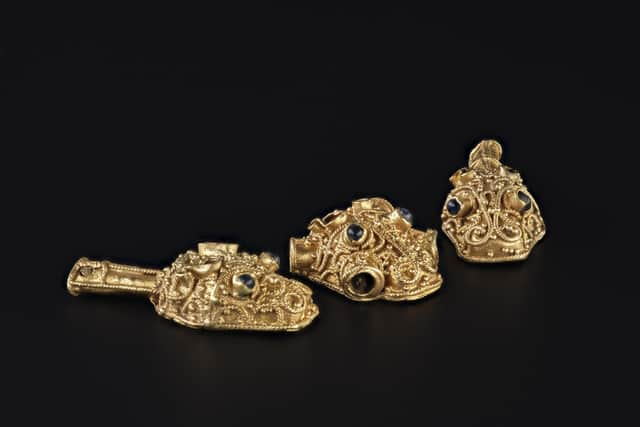Galloway Hoard: Mystery of the delicate gold treasures bound in silk
The objects, which were bound together with rare silk braids, a link not seen before, are part of the stunning collection of gold, silverware, jewels and rare textiles found by a metal detectorist in Dumfries and Galloway in 2014 and acquired for the nation for just over £2m.
Research continues into the hoard, which was buried around 900AD and is one of the most important archaeological discoveries in the UK for a century, in a bid to build the story about who it may have belonged to, why it was buried, where the objects came from and how they ended up in Scotland.
Advertisement
Hide AdAdvertisement
Hide AdThe gold filigree objects are often referred to as ‘aestels’, instruments which were previously thought to hold a piece of bone or wood and be used as a pointer to follow text when reading.
But conservators now believe the items had another use.
A statement from National Museums Scotland said: “This is the first time that a group of these gold objects have been found together and the associated textiles provide new clues to what they were used for.
“The presence of braided silk within the sockets on the gold objects shows that they were all connected and this new evidence casts doubt on the previous categorisation. Further research will be carried out on their true purpose and usage.”


Images of the items will go show for the first time at Aberdeen Art Gallery as the Galloway Hoard goes on the next stage of its national tour.
Researchers from the University of Glasgow have identified up to 12 different textiles in the collection, which were used to wrap the precious items but rarely survive when buried in the ground.
Dr Chris Breward, Director of National Museums Scotland said: “The exhibition is a fabulous opportunity to see the Hoard far more clearly than before and to gain an insight into the amazingly detailed work that we have done and are continuing to do in order that we can understand it more fully.”
The exhibition shows how the Hoard was buried in four distinct parcels. The top layer was a parcel of silver bullion and a rare Anglo-Saxon cross, separated from a lower layer of three parts. They contained silver bullion, a cluster of four elaborately decorated silver ‘ribbon’ arm- rings and a lidded, silver gilt vessel wrapped in layers of textile and packed full of carefully wrapped objects that appear to be have been curated like relics or heirlooms.
The Galloway Hoard goes on show in Aberdeen Aberdeen Art Gallery at the same time the 9th Century Book of Deer, a tiny book of gospels from the North East which contains the earliest examples of written Gaelic, is displayed.
Advertisement
Hide AdAdvertisement
Hide AdCouncillor Martin Greig, Aberdeen City Council culture spokesperson, said: "It is especially fortunate that the Book of Deer can also be seen locally just now. Together, these artefacts raise many questions about Scotland’s culture and identity right at the start of the Middle Ages. It’s important to have objects such as these on display in Aberdeen because inspecting and interpreting these kind of artefacts helps us to understand how modern Scotland came to be.”
Comments
Want to join the conversation? Please or to comment on this article.
